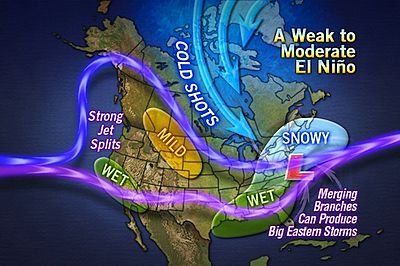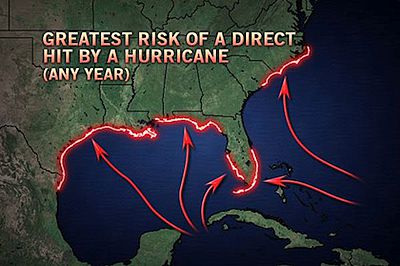Back to School: Kids Should See More Snow Days than Last Year


This article was provided by AccuWeather.com.
With the school year rapidly approaching, students are already wondering how lucky they'll get with snow days.?
Last winter, at least nine of the country's snowiest cities had less than 60 percent of their average snowfall, according to USA Today, which caused many schools to end the year early because they hadn't used up all their snow days.
The presence of El Niño or La Niña - and their strength - is used to project how active the winter season is going to be. AccuWeather.com Long-Range meteorologists are projecting a weak to moderate El Niño by late in the summer.
For kids praying to hear school's out for a snow day, the weaker the El Niño, the better. Weak El Niños have brought snow-packed winters to most major Northeast cities in the past, said AccuWeather.com Expert Senior Meteorologist Jack Boston.
"Historically, both strong La Niñas and weak El Niños have produced higher-than-average snowfall in the Northeastern U.S.," Boston said. In contrast, "weak La Niñas and strong El Niños historically bring lower-than-average snowfall."
A weak El Niño in 2009 led to record December snowfall in Philadelphia, which got slammed with 23.2 inches of snow. It was a year's worth of snow in one day for the city that usually receives 20.5 inches of snow in an average year, according to the National Oceanic and Atmospheric Administration.
Get the world’s most fascinating discoveries delivered straight to your inbox.
Deciding on a snow day is more complex than looking at the number of inches on the ground, however. A flurry could mean a school cancellation in South Carolina, but just another normal winter day in Michigan.
?Deirdre Darragh, the School District of Philadelphia's Manager of Media Relations?, said that ?in determining if schools should be closed, the district collaborates with city and state officials and the Office of Transportation, with the final decision being left to the superintendent.? They take into account the temperature and the timing of snowfall, and whether the snow will coincide during hours that students and faculty are in transit, she said.
Though cities in the Northeast are usually much better equipped than the South when dealing with snow, cancellations also rely on the school's size and location.
"In Philadelphia, our students are more spread out than a suburban area with a concentration of students in one area," Darragh said.
Snow isn't the only reason that schools close their doors, however.
Philadelphia has had to cancel school for heat and hurricane days as well. This May, high temperatures and humidity caused the district to end class early for more than 200 schools in the area.
Darragh said many of the schools' buildings were old and were not equipped with air conditioning.
?"[Heat closings] have happened a couple times in the past few years because there's a lot of older buildings in the city that are no equipped with air conditioning," she said. "It's difficult to ensure safety on a really hot day. If we feel student health might be in jeopardy, we'll dismiss early."?
As soon as schools start in August, students along the southern and eastern coasts will have already started preparing for hurricane season.
Dozens of other school districts along the Northeast last August celebrated their first "hurricane day" when Irene struck the coast. For many, it meant ?canceling class on their first day of school.?
?Districts like Miami-Dade County Public School, which comprises 392 schools in the southern Florida peninsula, are no stranger to hurricane preparation. But because school buildings are often utilized as public storm shelters, classes can end up getting cancelled for a while: In October 2000, schools were closed for two weeks after Category-5 Hurricane Wilma struck Florida's coast with the Atlantic's strongest storm on record.?
?The AccuWeather.com Long-Range Forecasting Team is predicting an average season of about five hurricanes and 12 tropical storms - less active than last year's seven hurricanes and 19 tropical storms. Hurricane season peaks in September and officially runs until Nov. 30.?
?The Atlantic Hurricane season affects the southern coast from Texas to Florida, as well as a large portion of the eastern coast from Florida all the way up through North Carolina, and can even impact cities as far north as New York or Boston.?
?In making the decision to close Miami-Dade schools, the public school district collaborates with the local Office of Emergency Management to determine whether conditions are safe enough to keep schools open.?
?Miami-Dade Emergency Management Deputy Director Jonathan Lord said as soon as the department begins tracking a hurricane, it alerts schools of the storm's approach.?
?Once a tropical storm becomes a Category-1 hurricane, the department begins designating shelters up to three days in advance for areas in the storm's threat zone. For schools that aren't used for shelters, Lord said they provide the school district with information about whether wind or flooding conditions are hazardous to school bus routes.?
?Lord then leaves it up to the school's board. Miami-Dade County Public School District Director John DiBenedetto said they consult other neighboring school districts, and the decision is again ultimately left up to the superintendent.?
© AccuWeather.com. All rights reserved. More from AccuWeather.com.



